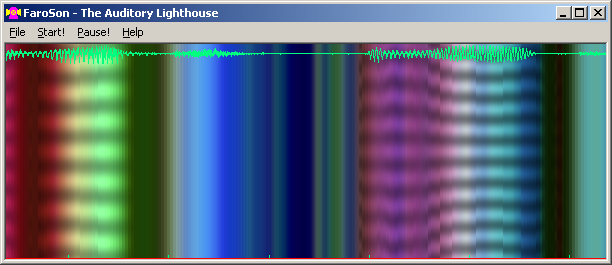FaroSon - The Auditory Lighthouse
FaroSon is a Windows PC program for the real-time conversion of sound into a coloured pattern representing loudness, pitch and timbre. It is useful when teaching concepts of sound sensation, particularly when the audience is not suited to an acoustical account involving spectral analysis. It is also rather a pretty way to look at speech.

Description
FaroSon (from "pharos" - lighthouse, and "son" - sound) is a program that turns sound signals into a scrolling coloured display in real-time. However, rather than presenting a physical analysis of the sound, Faroson attempts to present a psychological picture of the sound. While the horizontal axis of the pattern represents time, the other attributes of the picture are related to our subjective senses of loudness, pitch and timbre. The loudness of the sound is reflected in the brightness and saturation of the colours you see. The timbre of the sound is reflected in the colours themselves: sounds with predominantly bass character have a red colour, while sounds with a predominantly treble character have a blue colour. The pitch of the sound is reflected in the horizontal banding patterns: when the pitch of the sound is low, then the bands are large and far apart, and when it is high, the bands are narrow and close together. If the pitch of the sound is falling you see the bands diverge; when it is rising, you see the bands converge.
The input waveform is displayed at the top of the picture on a fixed amplitude scale to help you check that the input signal is a good size but not overloaded. At the bottom of the screen is a time axis, with tick marks every 100ms.
Download & Installation
The program is only available for Windows PCs from
To download the file, right click on the link above and choose "Save Target As". Save the file to your desktop or to a folder on your computer. Then run the file to install the program and to add an entry to your Start Programs menu. Once installed you can delete the downloaded file.
Technical details
The signal is divided into overlapping frames of about 30ms, where each frame represents one vertical line of pixels. Time advances by about 1ms per horizontal pixel. Each frame is Hamming-windowed and a spectrum is computed using a discrete fourier transform. The relative preponderance of red, green and blue used to represent the frame is calculated from the relative energy in the low, mid and high frequency regions of the spectrum. The amplitude of the signal in each window is logarithmically compressed to generate a measure of loudness: this is used to modulate the brightness and saturation of the colour. The log amplitude spectrum is input to a further fourier analysis to derive the cepstrum, from which an estimate of fundamental frequency is found by determining the delay of the first rahmonic. The autocorrelation of the window is computed and the size of the autocorrelation peak is used to provide an estimate of periodicity. The fundamental frequency value and the periodicity measure are used to modulate the intensity of the presented colour in the vertical dimension.
Configuration options
Since FaroSon performs a lot of calculations in real-time, it can fail to keep up with the input signal. To show when this fault occurs, the bottom-most pixel of the window is used to as an indicator. If this horizontal line of pixels shows gaps, or if the display is choppy or has repeating sections, then you may need to adjust some configuration options. Choose File|Configuration and adjust the options as follows:
- Screen refresh rate
- Controls how frequently the screen is updated. Range: from 5 frames/sec to 25 frames/sec. Default: 10 frames/sec. A higher rate gives a smoother scrolling display but puts more load on the graphics engine.
- Undersampling rate
- Controls how many frames are calculated directly and how many are calculated by interpolation. An undersampling rate of 3 means that one frame is calculated and two interpolated every three frames. Range: 1 to 5. Default: 3. A smaller value produces a display with fewer artefacts, but at a higher computational load.
- Display waveform
- Option to turn waveform display at top of window on and off.
- Display timescale
- Option to turn timescale display at bottom of window on and off.
Bug reports
Please send suggestions for improvements and reports of program faults to sfs@pals.ucl.ac.uk.
Please note that we are unable to provide help with the use of this program.
Copyright
FaroSon is not public domain software, its intellectual property is owned by Mark Huckvale, University College London. However FaroSon may be used and
copied without charge as long as the program remains unmodified and continues to carry this copyright notice. Please contact the author for other licensing arrangements. FaroSon carries no warranty of any kind, you use it at your own risk.



